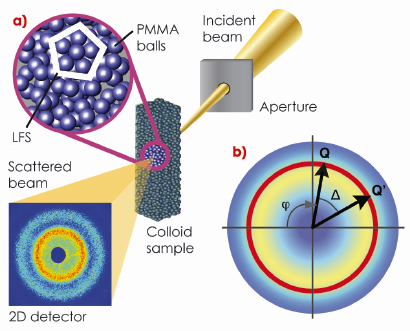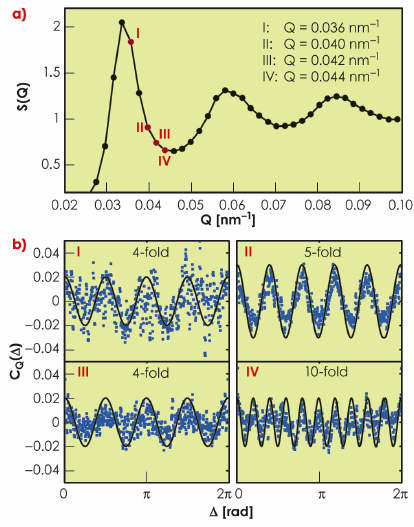- Home
- Users & Science
- Scientific Documentation
- ESRF Highlights
- ESRF Highlights 2009
- Soft condensed matter
- Finding order in disorder by X-ray speckle cross-correlation
Finding order in disorder by X-ray speckle cross-correlation
Disordered matter, such as glasses and liquids, does not exhibit translational symmetry. A particular system is able to accommodate sequentially different local symmetries, among them the icosahedral local order, which belongs to the forbidden motifs in periodic structures. This mysterious and so far experimentally inaccessible localised order within disorder has been fascinating scientists for many decades [1,2], as it is held responsible for the undercooling of liquids and the existence of the glass state. Yet it has been frustratingly difficult to characterise localised order quantitatively, since the commonly used tools such as X-ray and neutron scattering, which are capable of probing structure at atomic dimensions in bulk materials, yield only orientationally-averaged information embodied in the so-called “radial pair distribution function”, which simply tells you the average number of particles at a certain distance from a given particle. Without a periodic crystal lattice, the elegant methods of conventional crystallography cannot be applied. This limitation can be overcome if coherent light is scattered, like in a snapshot, from the instantaneous positions of all the atoms in the disordered sample. In this case, a speckle pattern is generated in the far field due to the interference of radiation coming from the entire scattering volume and the (not completely) random phase shifts by the particles. A speckle pattern represents a unique fingerprint via Fourier transform of the individual sample, rather than the usual ensemble average provided by scattering with partially coherent radiation. An example of such a speckle pattern is shown in Figure 71 together with a sketch of the experiment. In this study, highly concentrated glassy suspensions of sterically stabilised PMMA particles were investigated by coherent X-ray scattering at beamline ID10A. The envelope of the fluctuating speckle intensities is in fact the ensemble-averaged S(Q) scattering function that is normally measured from a glass or liquid as shown in Figure 72a. S(Q) depends only on pair-correlations and for amorphous samples does not depend on bond angles. To extract information on the local ordering hidden in the speckle pattern, the instantaneous scattered intensity was analysed for angular correlations by calculating a newly developed 4-point correlation function
CQ(![]() ) = (<I(Q,
) = (<I(Q,![]() ) I(Q,
) I(Q,![]() +
+![]() )>
)>![]() – <I(Q,
– <I(Q,![]() )>2
)>2![]() ) / <I(Q,
) / <I(Q,![]() )>2
)>2![]()
where ![]() is the azimuthal angle difference between two points in the speckle pattern (see Figure 71b). The averaging indicated by the brackets is taken over the entire ring
is the azimuthal angle difference between two points in the speckle pattern (see Figure 71b). The averaging indicated by the brackets is taken over the entire ring ![]()
![]() [0;2
[0;2![]() ] with |Q|=Q. Most fascinating is that CQ(
] with |Q|=Q. Most fascinating is that CQ(![]() ) in Figure 72b clearly reveals a very pronounced anisotropy with 5-fold symmetry specifically for the intensity ring associated with Q = 0.04 nm-1, which points to a so far hidden local symmetry in the colloidal system. The different Q-dependent symmetries are a signature of the specific local order. The colloidal glasses investigated here are slowly evolving; hence the analysis could be performed over time intervals much shorter than the typical speckle decay time (~200 s) to yield the temporal evolution of the local ordering. It is found that the bond-orientational order symmetries slowly relax as a function of time and switch e.g. from 5-fold to 6-fold at a given Q value. The emerging picture is that clusters of icosahedral order reorganise themselves and are formed either in nano-crystalline environments or out of complete disorder, all of which involves the breaking and formation of bonds. This bears similarities to the behaviour observed in simulations of supercooled molecular liquid glass-formers and underlines the importance of local rearrangements in the understanding of the dynamical properties of this important class of non-periodic materials. Clearly, there is a wealth of new information about the kinetics and the origin of the glass transition to be mined from such experiments, by e.g. applying correlators testing for medium range order. The availability of short-pulse XFEL radiation in the 0.1-nm regime and with sub 100-fs pulse length will open up the fascinating option to analyse the local structure of liquids (in particular water) by applying the new concept of X-ray cross correlation analysis (XCCA) to single laser shot speckle diffraction patterns.
) in Figure 72b clearly reveals a very pronounced anisotropy with 5-fold symmetry specifically for the intensity ring associated with Q = 0.04 nm-1, which points to a so far hidden local symmetry in the colloidal system. The different Q-dependent symmetries are a signature of the specific local order. The colloidal glasses investigated here are slowly evolving; hence the analysis could be performed over time intervals much shorter than the typical speckle decay time (~200 s) to yield the temporal evolution of the local ordering. It is found that the bond-orientational order symmetries slowly relax as a function of time and switch e.g. from 5-fold to 6-fold at a given Q value. The emerging picture is that clusters of icosahedral order reorganise themselves and are formed either in nano-crystalline environments or out of complete disorder, all of which involves the breaking and formation of bonds. This bears similarities to the behaviour observed in simulations of supercooled molecular liquid glass-formers and underlines the importance of local rearrangements in the understanding of the dynamical properties of this important class of non-periodic materials. Clearly, there is a wealth of new information about the kinetics and the origin of the glass transition to be mined from such experiments, by e.g. applying correlators testing for medium range order. The availability of short-pulse XFEL radiation in the 0.1-nm regime and with sub 100-fs pulse length will open up the fascinating option to analyse the local structure of liquids (in particular water) by applying the new concept of X-ray cross correlation analysis (XCCA) to single laser shot speckle diffraction patterns.
 |
|
Fig. 71: Sketch of the experimental setup where a speckle diffraction pattern is generated in the far field when coherent X-rays illuminate a disordered sample. a) illustrates the local isosahedral symmetry and b) outlines the XCCA analysis method. |
 |
|
Fig. 72: a) Angular-averaged structure factor, which is the standard radial intensity distribution. b) Experimental result after applying the cross-correlator CQ( |
In summary, we have demonstrated that local symmetries in disordered materials can be unravelled by the application of a novel angular cross-correlation technique to coherent X-ray scattering intensities. We uncovered the hidden local symmetries within the glassy disorder of suspensions of sterically stabilised PMMA particles. Four, 6, 10 and most prevalently 5-fold symmetries were observed pointing towards locally favoured structures (LFS) of icosahedral symmetry.
References
[1] F.C. Frank, Proc. Roy. Soc. Lond. A 215, 43-46 (1952).
[2] P.J. Steinhardt, D.R. Nelson and M. Ronchetti, Phys. Rev. B 28, 784-805 (1983).
Principal publication and authors
P. Wochner (a), C. Gutt (b), T. Autenrieth (b), T. Demmer (a), V.N. Bugaev (a), A. Díaz Ortiz (a), A. Duri (b), F. Zontone (c), G. Grübel (b) and H. Dosch (a,b), Proc. Natl. Acad. Sci. 106, 11511-11514 (2009).
(a) Max-Planck-Institut für Metallforschung, Stuttgart (Germany)
(b) DESY, Hamburg (Germany)
(c) ESRF



